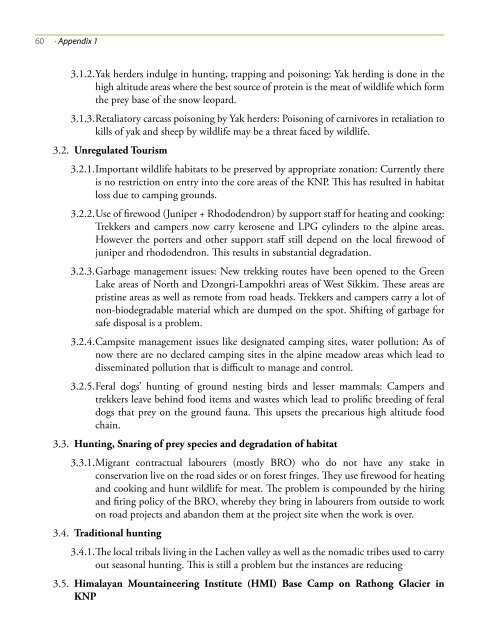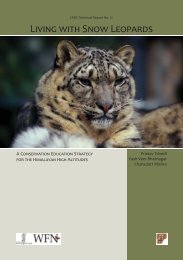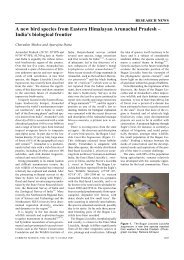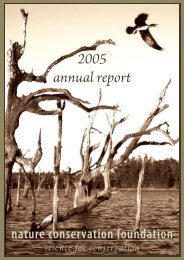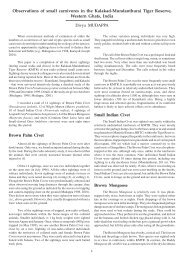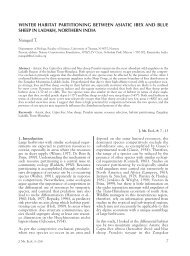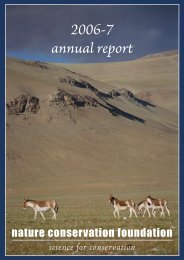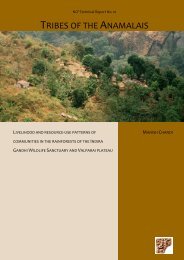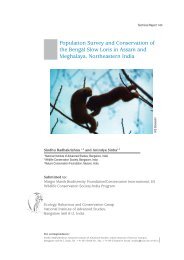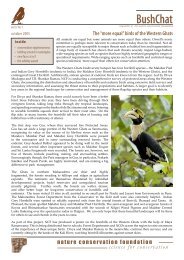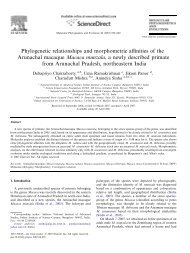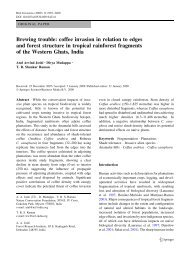towards project snow leopard - Nature Conservation Foundation
towards project snow leopard - Nature Conservation Foundation
towards project snow leopard - Nature Conservation Foundation
Create successful ePaper yourself
Turn your PDF publications into a flip-book with our unique Google optimized e-Paper software.
60 • Appendix 1<br />
3.1.2. Yak herders indulge in hunting, trapping and poisoning: Yak herding is done in the<br />
high altitude areas where the best source of protein is the meat of wildlife which form<br />
the prey base of the <strong>snow</strong> <strong>leopard</strong>.<br />
3.1.3. Retaliatory carcass poisoning by Yak herders: Poisoning of carnivores in retaliation to<br />
kills of yak and sheep by wildlife may be a threat faced by wildlife.<br />
3.2. Unregulated Tourism<br />
3.2.1. Important wildlife habitats to be preserved by appropriate zonation: Currently there<br />
is no restriction on entry into the core areas of the KNP. This has resulted in habitat<br />
loss due to camping grounds.<br />
3.2.2. Use of firewood (Juniper + Rhododendron) by support staff for heating and cooking:<br />
Trekkers and campers now carry kerosene and LPG cylinders to the alpine areas.<br />
However the porters and other support staff still depend on the local firewood of<br />
juniper and rhododendron. This results in substantial degradation.<br />
3.2.3. Garbage management issues: New trekking routes have been opened to the Green<br />
Lake areas of North and Dzongri-Lampokhri areas of West Sikkim. These areas are<br />
pristine areas as well as remote from road heads. Trekkers and campers carry a lot of<br />
non-biodegradable material which are dumped on the spot. Shifting of garbage for<br />
safe disposal is a problem.<br />
3.2.4. Campsite management issues like designated camping sites, water pollution: As of<br />
now there are no declared camping sites in the alpine meadow areas which lead to<br />
disseminated pollution that is difficult to manage and control.<br />
3.2.5. Feral dogs’ hunting of ground nesting birds and lesser mammals: Campers and<br />
trekkers leave behind food items and wastes which lead to prolific breeding of feral<br />
dogs that prey on the ground fauna. This upsets the precarious high altitude food<br />
chain.<br />
3.3. Hunting, Snaring of prey species and degradation of habitat<br />
3.3.1. Migrant contractual labourers (mostly BRO) who do not have any stake in<br />
conservation live on the road sides or on forest fringes. They use firewood for heating<br />
and cooking and hunt wildlife for meat. The problem is compounded by the hiring<br />
and firing policy of the BRO, whereby they bring in labourers from outside to work<br />
on road <strong>project</strong>s and abandon them at the <strong>project</strong> site when the work is over.<br />
3.4. Traditional hunting<br />
3.4.1. The local tribals living in the Lachen valley as well as the nomadic tribes used to carry<br />
out seasonal hunting. This is still a problem but the instances are reducing<br />
3.5. Himalayan Mountaineering Institute (HMI) Base Camp on Rathong Glacier in<br />
KNP


